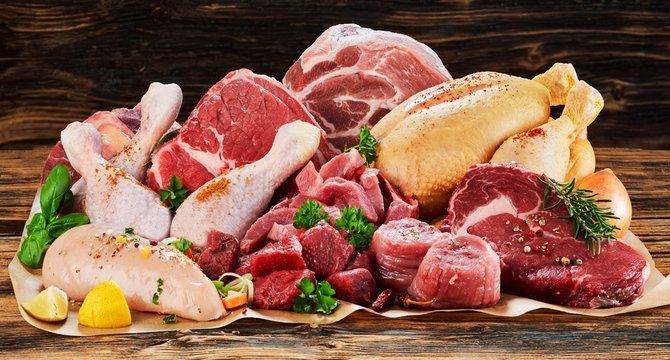Why pigs may not be the best choice in your diet
Why Pork May Contain More Toxins
Pork is one of the most widely consumed meats worldwide, offering a rich source of protein, vitamins, and minerals. However, concerns about toxins in pork have been raised, leading to debates about its safety and potential health risks. Several factors contribute to why pork may have a higher chance of containing toxins compared to other meats. These include the pig's biology and metabolism, farming practices, diet, and the potential for contamination with parasites and bacteria. Understanding these factors can help consumers make informed decisions about their diet and food choices.
1. The Biology of Pigs and Their Digestive System
One reason pork may contain more toxins is related to the biology and digestive system of pigs:
- Pigs Are Omnivores: Pigs have a non-selective diet and can consume a wide variety of foods, including grains, vegetables, and sometimes even spoiled food or animal waste. This diet can potentially expose pigs to various toxins that may accumulate in their bodies.
- Rapid Digestion Process: Pigs have a relatively short digestive tract compared to other animals like cows. This short digestion process means that their bodies do not filter out toxins as effectively. Unlike ruminant animals (e.g., cows), which have a multi-chambered stomach that helps detoxify food over a longer period, pigs process their food in just a few hours. This can lead to the accumulation of toxins in their tissues and fat.
2. Potential Exposure to Parasites and Bacteria
Another reason for the concern about toxins in pork is the risk of contamination with parasites and bacteria:
- Trichinosis (Trichinellosis): Pigs can carry Trichinella spiralis, a parasitic roundworm that can infect humans if they consume undercooked or contaminated pork. Trichinosis can lead to symptoms such as nausea, diarrhea, fever, muscle pain, and potentially more severe complications.
- Tapeworms (Taenia solium): Pork can also carry tapeworm larvae, leading to infections if not properly cooked. Tapeworms can cause digestive issues and, in rare cases, can migrate to other parts of the body, causing more severe health problems.
- Bacterial Contamination: Pork can be contaminated with bacteria like Salmonella, Listeria, and E. coli. These bacteria can cause foodborne illnesses, particularly if the meat is undercooked or improperly handled. While all meats can potentially harbor these bacteria, pigs' feeding and farming conditions can increase the risk of contamination.
3. Farming Practices and Living Conditions
The way pigs are raised can also contribute to the potential for higher toxin levels in pork:
- Industrial Farming Practices: In large-scale industrial farming, pigs are often kept in confined spaces, where they are exposed to high levels of stress, poor air quality, and unsanitary conditions. These conditions can lead to the proliferation of pathogens and toxins in the animals.
- Use of Antibiotics and Growth Hormones: To prevent disease and promote rapid growth, pigs are sometimes given antibiotics and growth hormones. Overuse of antibiotics can lead to antibiotic-resistant bacteria, which can be harmful if transmitted to humans through consumption.
- Diet and Feed Quality: The quality of feed given to pigs can significantly impact the toxin levels in their bodies. Some low-quality feeds may contain mycotoxins (toxins produced by mold), heavy metals, or pesticide residues. These toxins can accumulate in the pigs' bodies and, consequently, in the meat we consume.
4. Toxin Accumulation in Fatty Tissue
- High Fat Content: Pork is known for its high fat content, particularly in certain cuts like bacon, pork belly, and shoulder. Fatty tissues can act as storage sites for toxins such as pesticides, heavy metals, and other environmental contaminants. When humans consume fatty cuts of pork, they may be exposed to these toxins.
- Bioaccumulation: If pigs consume food or water contaminated with toxins, these substances can accumulate in their fatty tissues over time, leading to higher toxin levels in the pork.
5. Impact of Cooking Methods
- Risk of Under-cooking: Unlike beef or lamb, which can be consumed at varying levels of doneness (e.g., rare, medium), pork should be cooked thoroughly to kill any potential parasites or bacteria. Undercooked pork poses a higher risk of foodborne illness, especially if it contains Trichinella larvae or Taenia tapeworms.
- Formation of Harmful Compounds: Cooking methods like grilling, frying, or smoking pork at high temperatures can produce harmful compounds, such as heterocyclic amines (HCAs) and polycyclic aromatic hydrocarbons (PAHs). These compounds are potential carcinogens, which can increase health risks when consumed frequently.
6. Environmental Factors and Contaminants
- Exposure to Environmental Toxins: Pigs raised near industrial areas, waste disposal sites, or heavily polluted regions can be exposed to environmental toxins. These toxins may include heavy metals like lead, cadmium, or mercury, which can accumulate in the meat and pose health risks to consumers.
- Water Quality: The quality of water consumed by pigs also plays a role in their exposure to toxins. Contaminated water sources can introduce harmful substances like pesticides, industrial chemicals, and pathogens into the pigs' bodies.
How to Reduce Risks When Consuming Pork
While there may be concerns about toxins in pork, you can take several steps to reduce the risks associated with its consumption:
- Choose High-Quality, Organic, or Pasture-Raised Pork: Look for pork products labeled as organic, pasture-raised, or from reputable sources that prioritize animal welfare and sustainable farming practices. These pigs are generally raised in cleaner environments and fed higher-quality diets, reducing the risk of contamination.
- Cook Pork Thoroughly: Ensure that pork is cooked to an internal temperature of at least 145°F (63°C) for whole cuts, followed by a 3-minute rest period, and 160°F (71°C) for ground pork. Proper cooking kills parasites and bacteria that may be present in the meat.
- Avoid Processed Pork Products: Processed pork products like bacon, sausages, and deli meats often contain additives, preservatives, and higher levels of sodium and nitrates, which can contribute to health risks. Opt for fresh, minimally processed pork whenever possible.
- Practice Good Food Safety: Store pork properly, separate it from other foods to prevent cross-contamination, and maintain good kitchen hygiene to reduce the risk of foodborne illness.
- Moderate Consumption: As with any meat, moderation is key. Consuming pork occasionally as part of a balanced diet with plenty of fruits, vegetables, and whole grains can help minimize potential health risks.
Conclusion
While pork may have a higher chance of containing toxins due to factors like the pig's digestive system, farming practices, potential exposure to parasites, and the risk of environmental contamination, these risks can be mitigated by making informed choices. Opting for high-quality pork, cooking it thoroughly, and practicing good food safety can help reduce the risks and allow you to enjoy pork as part of a healthy diet. Understanding the sources of potential toxins and taking steps to minimize exposure is crucial for making healthier food choices.











